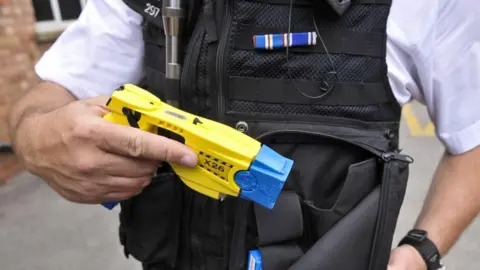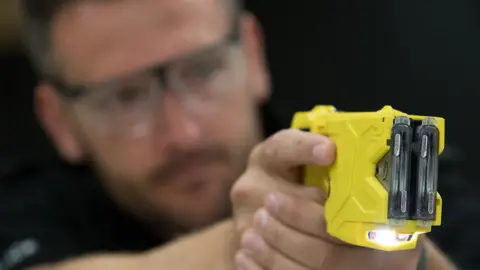Taser use by police in England and Wales reaches record high
 PA Media
PA MediaThe use of Taser stun guns by police and England and Wales reached a record high last year, Home Office figures show.
They were deployed in 23,000 incidents in the 12 months to the end of March - up by more than a third on the previous year and double the 2016 total.
In most cases, the devices were aimed at a suspect without being fired.
Civil liberty campaigners say Tasers can be lethal, but the police argue they are vital to ensure safety.
They have the support of the Home Office, which is providing funding to enable an extra 10,000 officers to carry them.
A Home Office spokesman said: "Police officers put themselves in harm's way to protect us and it is vital we give them the powers and equipment they need to fight crime and stay safe on the job."
The weapons - which deliver a high-voltage electric shock - were fired on 2,500 occasions between April 2018 and March 2019, which is thought to be the highest number recorded.
Conductive Energy Devices (CEDs) - known by their brand name, Tasers - were first trialled in UK police forces in 2003, and their use by specially trained officers was authorised five years later.
The roll-out to all forces was completed in 2013, when they were used 10,000 times.
The latest figures (23,000 deployments) represent a significant increase on the numbers recorded the previous year (17,000 deployments) and in 2016 (11,000 deployments).
The Home Office report in which the statistics were published says the increase in recent years may reflect the rise in "the number of CED-trained officers and CEDs available", or "officers dealing with more incidents with the potential for conflict".
The report looks more broadly at the use of force by police in England and Wales.
In total, there were 428,000 recorded incidents in which a police officer used force.
Restraint tactics, such as handcuffing, were the most common type of force - and were used 401,000 times.
The statistics also reveal that specially trained firearms officers in England and Wales discharged baton rounds, sometimes known as plastic bullets, 43 times last year.
They were fired twice at children aged between 11 and 17.
 PA Media
PA MediaTo be issued with a Taser, police officers must have completed 18 hours of training and are then required to undergo a compulsory refresher course every year.
A petition demanding all police officers in the UK are issued with Tasers has reached more than 113,000 signatures.
John Apter, national chair of the Police Federation, told the BBC in August that officers say they feel "vulnerable and often isolated due to the lack of this vital protective equipment".
"Ultimately, having a Taser gives them the capability to defend not only themselves but also the public they want to protect," he said.
However, Taser use remains controversial. According to Amnesty International, 18 people in the UK have died after a Taser was discharged against them by police since the device was introduced 16 years ago.
Oliver Feeley-Sprague, Amnesty UK's police and security programme director, said: "A large number of officers fail the Taser training course, either in the proficiency of using it or their judgement about when to use it. This demonstrates very clearly that a Taser is not suitable for every officer."
